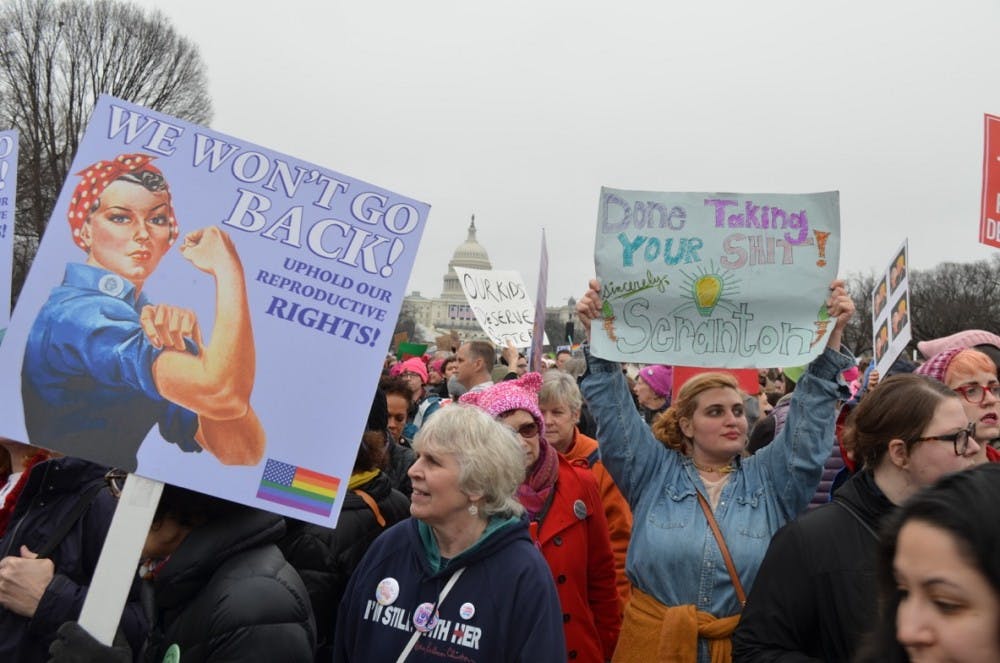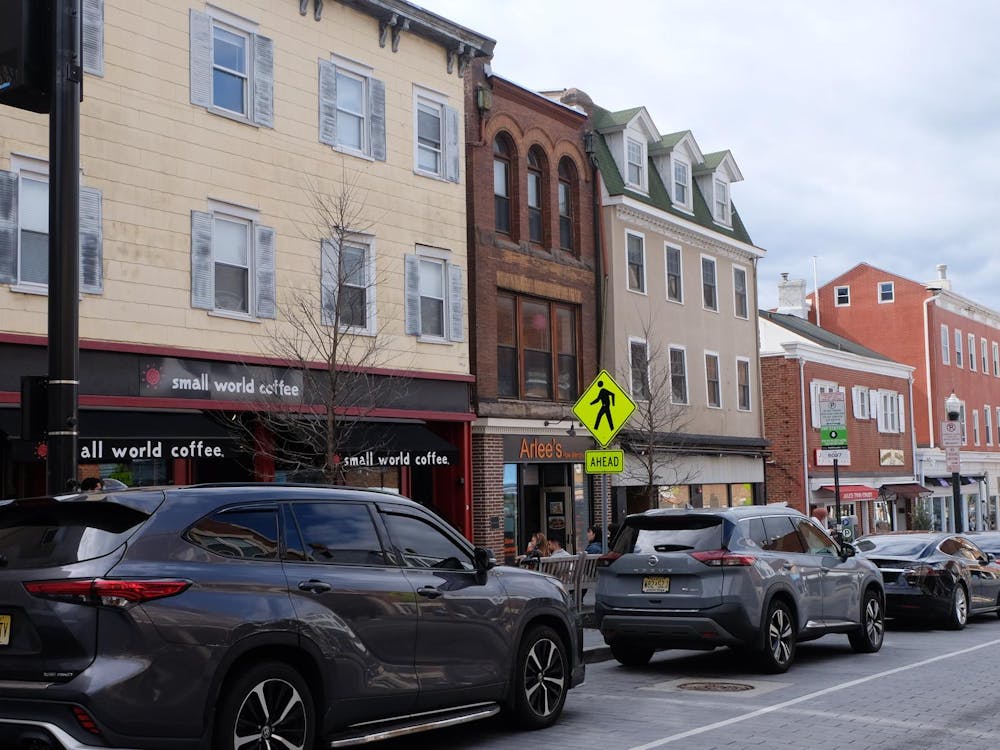WASHINGTON, D.C. – In a strong response to yesterday’s inauguration, hundreds of thousands of marchers descended on the capital. Due to the crowd’s size, the march could not proceed as planned. Attendees instead gathered to hear artists, speakers, meet with each other, and march through city streets in a less organized fashion.
Marches took place all over the world with numbers reaching as high as 750,000 in Los Angeles, 600,00 in Washington, D.C., and 200,000 in New York City. Even abroad, people took to the streets from Sydney, Australia all the way to London, England. Among the marchers along the East Coast, University students joined the throng.
Nate Lambert ’20 attended the march in Washington with 10 members of the Princeton College Democrats to “recognize the grave threat that Trump and the Republican Party pose toward women’s rights.”
The atmosphere was positive and empowering, Lambert said.
“I also had heard that the march would be massively attended, and I wanted to be a part of this piece of history and resistance," Lambert said.
Sarah Baber ’18 attended the Washington D.C. women’s march with ten other Princeton students. Although they had originally planned to take a rally bus chartered by the Women*s Center, logistical issues forced them to rent two cars and drive to Washington D.C. on their own.
“At first we were surprised by how little traffic there was but as we got closer we noticed a long line of cars and buses,” Baber said. “That’s when I realized how huge this march really was.”
Student groups that participated included the Princeton College Democrats, Princeton Students for Gender Equality, Princeton Students for Reproductive Justice, the Center for Jewish Life, and the Women*s Center.

Scheduled to begin at 10 a.m. in Washington, D.C., the National Mall and the surrounding areas began to throng with people well before then. Grey skies threatened all day, but the rain kept at bay. Clouds covered the tip of the Washington Monument, hiding it from photos.
While not all student marchers attended the Washington, D.C. event, the marches in Trenton, New York City, and around the world share similar characteristics. The marches’ goals are for a progressive, intersectional platform; they don’t focus solely on women’s issues. Lambert wrote that he thought the march was a good mix of “people with hijabs, pride flags, B[lack] L[ives] M[atter] shirts, and even socialist messages.”
According to the Women’s March website, the march has been coordinated at the state level around the United States in the hopes that numbers “too large to ignore” will garner action from the new administration in its first day in office.
“We stand together, recognizing that defending the most marginalized among us is defending all of us,” the website stated.

Across the Mall, as individuals and families gathered, milling around and buzzing with excitement, members of each generation shared encouragement and support with each other.
“We’re here because this stuff just doesn’t take care of itself,” said a mother to her child in Washington.
One thing that caught Baber’s attention was a father holding his young son on his shoulders. “There is a common misconception that feminism is only for women,” Baber said, “it is actually for everybody.” She then went on to express her admiration for what that father was teaching his son.
Baber also recalls meeting an elderly woman in the metro who had protested against the Vietnam War years ago. “It had truly come full circle,” Baber observed.
Lambert wrote that the atmosphere was extremely positive and empowering.
“Everyone was excited to join in on chants and took genuine interest in reading and commenting on one another’s signs,” Lambert wrote. “Especially towards the end of the march, when protestors continued to march past the White House due to an unexpectedly big turnout, the energy of the crowd was infectiously urgent and forceful.”
Baber explained that she had become tired of hearing people say to hope for the best for Trump's administration. “This movement was about making sure that Trump’s offences are not ignored and that his rhetoric doesn’t succeed,” Baber said.
The Washington D.C. that Baber knew had been completely transformed. “Everything was shut down,” she said. “It wasn’t business as usual.”
The march seemed "oddly organized," according to Sharon Musa '20, who attended with the Women*s Center.
"Everyone was working together. It wasn't chaotic at all," she said, noting that the crowds were self-managing despite the lack of formal direction.
“The march exceeded its goals,” Baber said. “The sheer number of people there sent a clear message to President Trump.” Sarah ended by saying that this is the first step of many and that “this march had created a new set of goals for the future.”
Younger individuals climbed atop scaffolding for TV sets left from yesterday’s inauguration. Such remnants of the ceremony were stationed throughout the city including a 58th Presidential Inauguration banner and numerous flags along major roads. The protest itself is the largest post-inauguration speech in history, according to The New York Times. Its goals manifested themselves in posters and pink so-called p*ssyhats.
Posters highlighted women’s rights, inclusion, climate change, income inequality, Black Lives Matter, and rips on the 2016 election. One woman’s shirt read “Accomplishments: Daughter Sister Wife Mother Aunt Grandmother Citizen.” Posters also took more creative forms, such as used tampons. Another was a cut-out of Russian President Vladimir Putin with a puppet form of Trump dangling from a string.
The most common posters were three red, white and blue representations of three women created by the same artist who made the iconic “Hope” image of then-Presidential candidate Barack Obama.
Other University students also went to protest in New York and Trenton.
Tomi Lawal ’20 and Winfred Darko ’20 joined the CJL in New York City’s Women’s March. After attending a service at B’nai Jeshurun Synagogue on Broadway, the group walked from 88th St. to 42nd St. with the synagogue and joined the march.
“There were tons of people and they were chanting ‘hey hey, ho ho, misogyny has got to go’ and ‘This is what democracy looks like,'” Darko said. He added that many of the chants were in a call-and-response format.
On 5th Ave., from 42nd St. to 56th St., there was a police blockade, Darko said, to protect Trump Tower. Most marchers thanked the officers for their help as they walked past, he said. Darko explained that the march included a lot more women than men, many families with their children, older individuals in wheelchairs, and other representations of the diversity. He described the march as organized, energized, and peaceful.
“The signs were provocative, but the march itself was respectable,” Darko said. “It was nothing like the riots on TV yesterday,” adding that they seemed like a visceral reaction to the inauguration to him.
“The purpose of this march was clearly defined,” Darko said.
Valerie Wilson ’18 attended the women’s march in Trenton with a group of students from Pink House, a sustainability group on campus. She explained that Trenton was a great option for her and other University students considering the logistical issues at hand.
Wilson estimated that over 10,000 attended the Trenton march, many more than were initially expected. The diversity of people there caught her attention. Wilson said that “the event organizers did a good job ensuring that the speakers reflected this diversity; be it through race, sexual orientation etc.”
“Many aspects of the inauguration didn’t sit well with me,” Wilson said. “For me, this march was about demonstrating raw resistance and encouraging civic participation in the city of Trenton.”
Wilson then told the story of the closing speaker at the Trenton women’s march, a 91-year-old African-American woman who had fought against segregation and discrimination all of her life. She had devoted 80 years to the civil rights movement and was instrumental in getting support for Martin Luther King in the Trenton area.
With this in mind, Wilson ended by saying that “the rally was organized with a lot of attention to history and oriented towards the right things.”
Among the Washington, D.C. performers were Madonna and Alicia Keys, who both gave impassioned speeches for why they attended the march and why its mission was important before performing.
In the early afternoon, Trump made a speech at CIA headquarters in Langley, Va. on the subject of crowd sizes between his and Obama’s inaugurations, calling it a “massive field of people” and that he has a “feud with the media." He also spoke about the number of times he has appeared on the cover of Time Magazine. He emphasized strong support for the CIA and the amount of presidential backing they would receive in the future – so much so that the CIA might actually ask for less backing.
In a press conference in the late afternoon, Press Secretary Sean Spicer made a statement regarding the size of the inauguration crowds during President Donald Trump’s and President Barack Obama’s inaugurations. He claimed that this was the “largest audience ever to witness an inauguration. Period.” Spicer also noted that Twitter can be used in a misleading way, referencing a New York Times reporter who had tweeted that a bust of Dr. Martin Luther King, Jr. had been removed from the Oval Office when it had not. The reporter later apologized. After making his statement, Spicer left without answering any questions from the waiting press. Spicer did not discuss the Women’s March on Washington.








